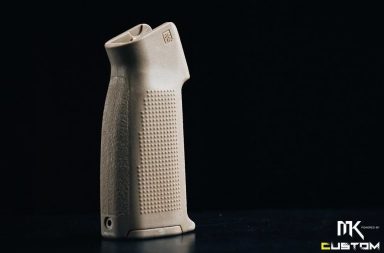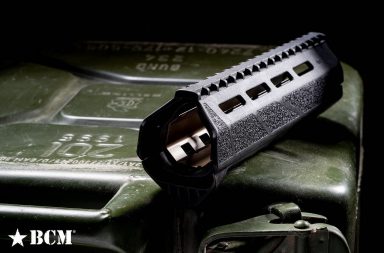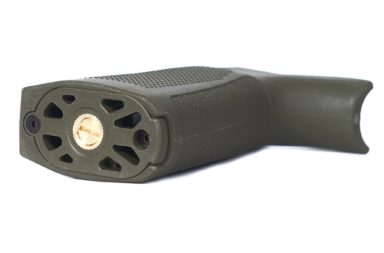There are many fundamental elements to differentiating between a good rifle and a bad rifle. One of these elements relate to the ergonomics and functions of the rifle’s furniture. This review focuses on the one of many collapsible stocks which have been specifically designed to provide ergonomics, recoil dampening (not for Airsoft) and battery compartment (not for… well, it could be).
PTS is a professional training company that specialises in providing military based accessories for replica training weapons. The PTS Enhanced Polymer Stock, otherwise known as the EPS, is a new addition to the PTS range designed to improve upon current generation stocks and any issues that have surfaced from their use.
To start off, we will have a look at the PTS Enhanced Polymer Stock otherwise known as the EPS. The EPS recently debuted on our website alongside the GBLS DAS GDR-15 and has already had some prior testing due to the review process of the GBLS DAS system itself. It is worth noting that the EPS may seem more weathered compared to the EPS-C as it has been used for a much longer period of time.
The PTS Enhanced Polymer Stock is a fully functional polymer stock that is designed to offer full dexterity to the user with a rubberized removable buttpad for batteries and other miscellaneous items. The main structure of the EPS is made out of Dupont Zytel (nylon) which is a very strong polymer designed against wear and flexing.
The EPS is compatible with both GBBR and AEG buffer tube diameters of 1.148 inches and weighs 332g on its own. At 205 x 135 x 63 mm, the EPS is a fairly medium to large stock with a battery capacity of at least 139 x 31 mm on both sides of the stock (ignoring space in the buffer tube). The rubberized buttpad is removed quite simply by pressing down on two notches on either side of the back of the stock.
The slick design of the EPS is done to ensure that there is little chance of sling or webbing to catch against it during operation or general carry. It is worth noting that this design principle has been applied to the adjustment lever, quick detach sling attachments and the sling loop retainer at the bottom of the stock (very useful if you find that your sling interferes with the seating of the buttpad against the body).
The QD sling attachments are hollow and connected, allowing for the multipurpose use of the attachments to be used alternatively as a keyhole for a sling to go through instead. Although it seems over-engineered, these features are subtle and hence don’t play any negative effect on the overall application of the stock.
The adjustment lever of the stock is very low profile which can be both a pro and a con to the function of the stock. It is worth noting that there is a “safety” on the frame where the adjustment lever lies which stops accidental depression of the lever. This has proven effective however it has also made it more difficult to simply pull the lever and adjust the stock along the buffer tube. This is an issue which can need some getting used to.
The rubberized pattern on the buttpad is not very abrasive and does not feel like it would make much of a difference where the stock would get wet or muddy. Testing has shown that although the rubber has allowed for the stock to grip better in wet conditions, the pattern on the pad has proven to do little but to trap dirt and provide a pleasing aesthetic when clean.
When shouldering the EPS, the stock feels fairly comfortable and does not jab into the body in a piercing fashion as other stocks can. The slanted angles at the front and back allow for slings to move freely but also allows for a soft and amiable cheek weld as the surfaces are smooth and do not catch on users of the bearded variety.
The storage capabilities as expressed before are similar to that of a MOD 1 Crane Stock with compartments on both sides of the buffer tube for batteries of varying types and sizes, these storage areas are also useful for tools, miscellaneous items or adding weight to manage the overall balance of the rifle it is attached to. This is a major advantage as it can sometimes be difficult to find a stock option which allows for a range of batteries to be fitted to it.
For the GBLS DAS GDR-15 we were recommended in getting an 11.1v LiPo nunchuck battery which easily fits in the two compartments of the stock with ample room for wiring which has provided more than enough power for the DAS considering the buffer tube is inaccessible for storage due to design and function. There was a good reason why GBLS debuted their first production models with this stock.
The EPS is not the only stock in the PTS range as there is now a new more compact version to the original design that we have just covered. Along came the EPS-C or otherwise known as the Enhanced Polymer Stock Compact. This stock borrows a lot of the features of its older brother, however in a more compact and potentially ergonomic application that would please a lighter specification.
The EPS-C is made of the same materials as the EPS and uses the same design principles to avoid any snagging from slings and items of clothing. At 175 x 40 x 130 mm, the EPS-C is much smaller and lighter than its older brother at 231g. It is worth noting that there is potentially no battery storage capabilities other than in the buffer tube itself, if possible.
The EPS-C is also compatible with both GBBR and AEG buffer tube diameters of 1.148 inches and has a removable buttpad much like the Magpul CTR stock with 2 removable hex screws in the back. The rubberized pad at the back is not easily removable as it is suggested that it would be easier to remove the entire stock to access the buffer tube compared to removing the buttpad instead.
The compact version uses the same sleek design patterns as the other, with QD sling attachments on both sides. It however does not connect both QD mounts as part of the initial design (it is possible to create the keyhole by disassembling the QD mounts themselves). It is not understood why it wasn’t retained however we can assume it was because of a lack of material on the frame itself.
The adjustment lever of the compact stock is similar in design to the original with the same “safety” extrusion on the frame to stop accidental depression of the lever. Once again, this design does take some getting used to but does provide a robust and effective way to avoid the stock adjustment occurring by accident. Take note that the EPS-C adjustment lever rocks both ways which allows for the stock to be more easily removed than the other version.
The rubberized buttpad uses the same design on the back as the other version and has shown to be the same during testing. It has a smaller surface area than the other which means that it is slightly less comfortable, however, it has proven to be more secure due to the compact feel and size of the stock. You are more likely to feel recoil from the use of the EPS-C compared to the EPS as you are sacrificing size and dampening for ergonomics and lightweight application.
The EPS-C feels very light and ergonomic which has allowed for quicker transitioning and less weight overall. The cheek weld is less pronounced however it allows for a higher purchase for raised optics and other applications that require a taller shooting perspective. The weight of the stock can be a disadvantage on heavy rifles that are not well balanced, so it’s worth making sure that the EPS-C doesn’t end up making the rifle unbalanced and hence affect the ergonomics of shooting.
Comparing the two EPS products side by side, you can see the minor differences in the designs and how they can change the look of a rifle. A good stock is essential to the feel, look, and application of the rifle and is considered a major factor between whether a rifle is good or bad. Having access to QD attachments and available storage can be just as important depending on the application and the user involved.
Overall, the PTS EPS series are very well designed stocks with many discreet features that are slowly becoming a standard across the industry. Certain features in design such as the principle of avoiding snag are very welcoming and should be a standard for stocks in the future. There is little that would normally be said about stocks as each brand seems to design them based on each other with little feats of innovation occurring in pockets before being adopted overall.



















